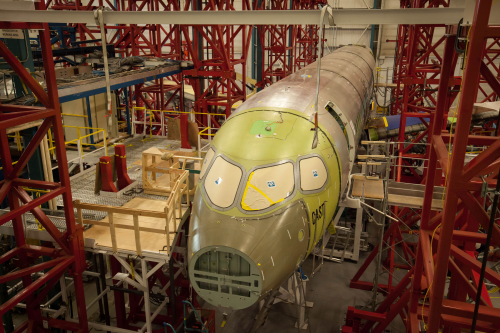
The cockpit and all fuselage sections for the first flight test vehicle (FTV1) have arrived at Mirabel, the production site for the CSeries aircraft, and its assembly is in progress.(VIEW THE VIDEO HERE.)
In addition, the first CSeries wings are now being mated to the test airframe that will be used during the Complete Airframe Static Test (CAST). Located at the company’s Experimental Test Facility in St-Laurent, Québec, the CAST is designed to demonstrate the static strength of the airframe and show compliance with certification requirements.
Composites reduce CSeries' weight
The CSeries makes use of advanced materials to reduce weight and fuel burn. The aircraft features an aluminium fuselage and composite wing, nacelle, rear fuselage and empennage. Use of these materials has resulted in over 2000 lbs in weight savings, Bombardier reports.
The CSeries wings were built at Bombardier’s new manufacturing and assembly facility in Belfast, Northern Ireland, which is responsible for the design, manufacture and integration of the composite wings for the CS100 (100-125 seat model) and CS300 (120-145 seat model).
Bombardier Aerospace Belfast has developed and patented its resin transfer infusion (RTI) process used to manufacture the primary structural components of the CSeries wings. Bombardier points out that use of composites in such a large structure as the wing provides weight savings, but additional benefits include fewer inspections and therefore lower maintenance costs thanks to the corrosion resistance properties and fatigue strength of the composite material.
The composite manufacturing process employed in Belfast also permits a high degree of accuracy and aero smoothness to minimise drag and therefore reduce the CSeries aircraft’s fuel burn.
The carbon fibre composite wings for both the CS100 and CS300 aircraft have an approximate area of 1209 ft2 (112.3 m2) and a span of 115 ft 1 in (35.1 m). Some of the internal parts for the wings of the two models will be different, but they have the same aerodynamic profile.
Bombardier Belfast manufactured the centre fuselage for FTV1, while the forward and aft fuselage sections, as well as the cockpit, were supplied by Bombardier’s St-Laurent facility. The rear barrel was supplied by Shenyang Aircraft Corporation (SAC), a subsidiary of China Aviation Industry Corporation (AVIC).
For the carbon fibre composite aft fuselage, including the pressure dome, Bombardier is utilising automated fibre placement (AFP) techniques.
Bombardier has booked orders and commitments for 352 CSeries aircraft.
Also see:
Bombardier throws down the gauntlet with CSeries airliner (feature article): To beat the opposition on fuel and maintenance costs requires a light but durable airframe and to achieve this Bombardier has opted for a 46% composite structure. This, together with other advanced materials, a radical geared turbofan (GTF) engine from Pratt and Whitney and an advanced supercritical wing will, the company predicts, deliver the goods.






